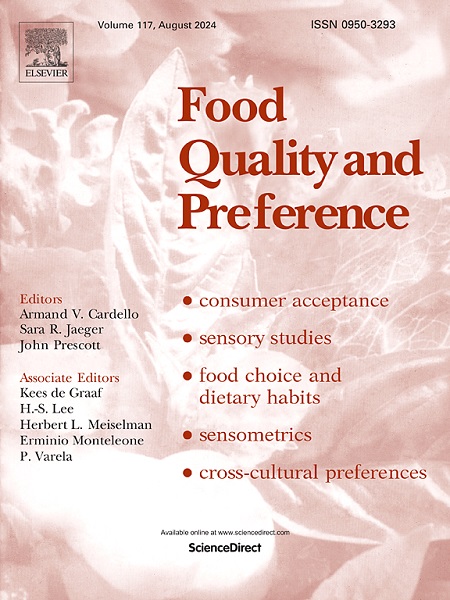Food consumption motivations override and moderate the effect of nutrition label on responses to (un)healthy products
IF 4.9
1区 农林科学
Q1 FOOD SCIENCE & TECHNOLOGY
引用次数: 0
Abstract
Front-of-package (FOP) labels, highlighting key nutrition information of food products, have garnered interest as a means to promote healthy eating. However, previous studies have shown limited effects of FOP labels, warranting further investigation. This paper examines how an interpretive summary indicator FOP label influences consumers' cognitive, senso-emotional, and behavioural responses to (un)healthy ready-to-eat meals. Additionally, it explores the role of consumer motivations (health, pleasure, and sustainability) in relation to a FOP label. Two between-subject studies were conducted online (Study 1: N = 516) and in a lab (Study 2: N = 116), along with a real-life experiment in a lunch buffet (Study 3: N = 1166). Studies 1 and 2 revealed that consumer motivations had a greater impact than a FOP label on cognitive (nutrient content and healthiness perceptions, purchase intention) and senso-emotional (taste perceptions and emotions) responses. Motivations also moderated the FOP label's impact: FOP label improved emotions related to the unhealthy product among health-conscious consumers, suggesting a health halo effect. FOP label might also be a sign to consume more among those not motivated by health, pleasure, or sustainability. In Study 3, demonstrating the behavioural impact, FOP label either increased or had no effect on the proportion of healthy food consumed, depending on the product. The results indicate that FOP labels have limited and mixed effects on product responses and may even be counterproductive in promoting healthy diets among some consumers. These findings assist policymakers and food marketers in identifying consumer groups and products that benefit from FOP labels indicating better nutritional quality.
食品消费动机超越并缓和了营养标签对(非)健康产品反应的影响
包装正面(FOP)标签突出了食品的主要营养信息,作为促进健康饮食的一种手段,已经引起了人们的兴趣。然而,先前的研究表明FOP标签的作用有限,值得进一步研究。本文考察了解释性摘要指标FOP标签如何影响消费者对(不)健康即食食品的认知、感觉-情感和行为反应。此外,它还探讨了与FOP标签相关的消费者动机(健康、愉悦和可持续性)的作用。两项受试者之间的研究在网上进行(研究1:N = 516),在实验室进行(研究2:N = 116),以及在自助午餐中进行的现实实验(研究3:N = 1166)。研究1和2显示,消费者动机对认知(营养含量和健康感知、购买意愿)和感官情感(味觉感知和情绪)反应的影响大于FOP标签。动机也缓和了FOP标签的影响:FOP标签改善了有健康意识的消费者对不健康产品的情绪,表明存在健康光环效应。FOP标签也可能是那些不以健康、快乐或可持续性为动机的人消费更多的标志。在研究3中,显示行为影响,FOP标签增加或没有影响健康食品的消费比例,取决于产品。结果表明,FOP标签对产品反应的影响有限且好坏参半,甚至可能在一些消费者中促进健康饮食方面适得其反。这些发现有助于决策者和食品营销人员确定受益于表明更好营养质量的FOP标签的消费者群体和产品。
本文章由计算机程序翻译,如有差异,请以英文原文为准。
求助全文
约1分钟内获得全文
求助全文
来源期刊

Food Quality and Preference
工程技术-食品科技
CiteScore
10.40
自引率
15.10%
发文量
263
审稿时长
38 days
期刊介绍:
Food Quality and Preference is a journal devoted to sensory, consumer and behavioural research in food and non-food products. It publishes original research, critical reviews, and short communications in sensory and consumer science, and sensometrics. In addition, the journal publishes special invited issues on important timely topics and from relevant conferences. These are aimed at bridging the gap between research and application, bringing together authors and readers in consumer and market research, sensory science, sensometrics and sensory evaluation, nutrition and food choice, as well as food research, product development and sensory quality assurance. Submissions to Food Quality and Preference are limited to papers that include some form of human measurement; papers that are limited to physical/chemical measures or the routine application of sensory, consumer or econometric analysis will not be considered unless they specifically make a novel scientific contribution in line with the journal''s coverage as outlined below.
 求助内容:
求助内容: 应助结果提醒方式:
应助结果提醒方式:


